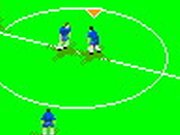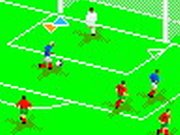Soccer games tend to fall into two camps: They are either fast arcade offerings that are made just for kicks (pardon the pun), or they are realistic simulations with micromanagement qualities. While Gameloft's last soccer title, the fun-loving Marcel Desailly Pro Soccer, fit well into the first category, 2004 Gameloft Real Soccer fits squarely in the second camp. Soccer junkies will take to the new game well, but other players may be turned off by its high learning curve.

2004 Gameloft Real Soccer has more than three dozen teams available, from Argentina to Uruguay. Each team is ranked by attack, defense, speed, and reach. Three types of games can be played: exhibition, European cup, and international cup. An exhibition match is a one-shot contest that's perfect for a quick game or for practice against the computer. Matches of this type are customizable by game length (three, six, or 10 minutes), difficulty (junior, amateur, or pro), and overtime (on or off). Longer games can be played in European and international cup competitions, with the main difference between them being the number of competitors (16 in European play and all 38 in international play). Game time and difficulty can also be chosen here, but overtime is mandatory. The countries are further divided into lettered groups, like group A and group C, and you can randomize these divisions to mix things up a bit.
Even the best players will have a difficult time scoring on the computer, because it has expert skill even in the junior difficulty mode, and it rarely misses an opportunity to steal the ball. This is particularly frustrating, because there's no multiplayer mode for 2004 Gameloft Real Soccer, so there's really no opportunity to practice in a less cutthroat environment.
Adding to the game's difficulty is that despite the layers of customizable options, the instructions are missing. Unless a game is a variant of Breakout, it needs in-game instructions. In this case, Gameloft Real Soccer needs instructions that specifically cover "how to kick the ball" and "how to pass." There is a special meter to help you score a goal, but no insight is given as to how to use it. The options screen even offers two different control methods, type 1 or type 2, but it doesn't actually explain what the differences are between them!

Even beyond the actual controls, soccer has technical components that gamers may be unfamiliar with. For instance, the pause menu gives you the opportunity to swap players to different positions. Great! But what do the position letters "GK" stand for? And, more importantly, what do they mean? If this is immediately intuitive to you, then Gameloft Real Soccer may be up your alley--otherwise, maybe it isn't.
Luckily, the controls in 2004 Gameloft Real Soccer seem fairly simple. An arrow sits over your current player, and when a teammate is available, the arrow shifts to him. You can then press 5 on the keypad to pass the ball. The 5 key also seems to change the highlighted player when you're on defense.
The multiuse 5 button is used for performing a goal kick as well. During goal kicks, a meter at the bottom of the screen widens and shrinks based on, presumably, the probability of your successfully making the shot.
One area where 2004 Gameloft Real Soccer excels is on the audiovisual end. The music is sparse, but during the option screens, the game plays peppy theme music. The sound effects are equally sparse, but the referee whistles and other minute details are on point. The graphics are great, showing well-shaded little men that run with enthusiasm and kick like their human counterparts. The men also seem to cry a little after being tripped.
The gameplay itself is fast and furious. The controls are responsive, considering the game speed, though you do have to be on high alert to keep up with the action. The raised side view works well for the game, and it scrolls just fast enough to keep the ball midscreen. Two icons at the bottom show the player currently highlighted on each team, making it easy to know who has the ball.
In the end, it is possible to understand what's going on in 2004 Gameloft Real Soccer enough to play a game, but its missing instructions--coupled with its high difficulty level--put a damper on the fun.